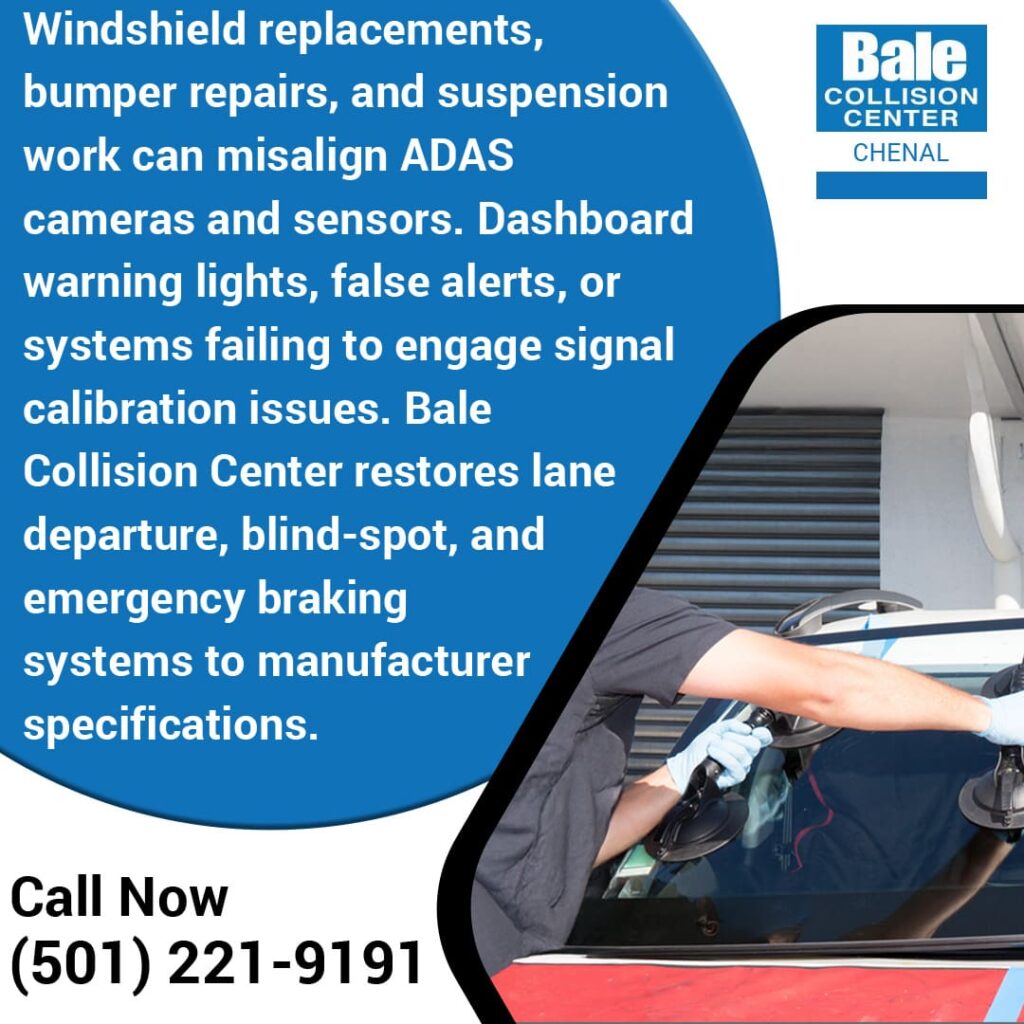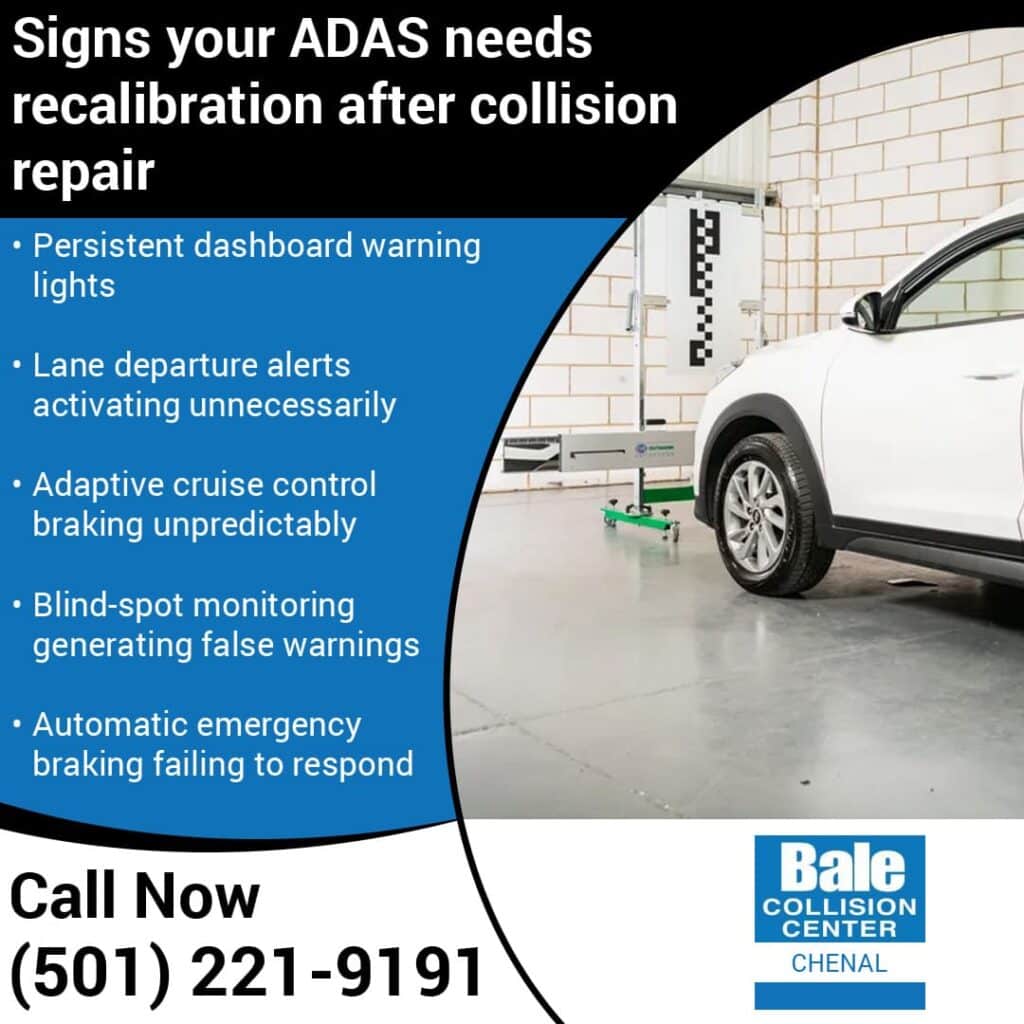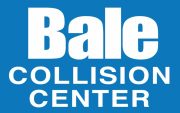Advanced Driver Assistance Systems (ADAS) are built into many modern vehicles to support safe driving through features like lane departure alerts, blind-spot monitoring, adaptive cruise control, and automatic braking. These systems rely on precise calibration of cameras, sensors, and radar equipment to function as intended. After a collision, windshield replacement, suspension work, or any auto body repair, calibration can be disrupted. If ADAS is not properly recalibrated, it can lead to inaccurate alerts or failure of safety features, putting drivers and passengers at unnecessary risk.
Bale Collision Center (Chenal) has served the Little Rock community since 1952, delivering certified auto body repair in Chenal Parkway, Little Rock, AR. Our experienced team uses advanced diagnostic tools to bring every vehicle back to its original manufacturer standards. Customers rely on us not only for collision and car body repair, but also for accurate ADAS calibration that protects safety on the road.

What Is ADAS and Why Calibration Matters
ADAS (Advanced Driver Assistance Systems)are vehicle technologies that support safer driving through sensors, cameras, and radar. These systems assist drivers by monitoring the road, detecting hazards, and activating safety features when needed.
ADAS includes tools like lane-keeping alerts, blind-spot detection, and forward-collision warnings. Each feature depends on precise sensor alignment. If sensors or cameras shift after an accident or repair, ADAS may misread traffic conditions. That can cause incorrect alerts or system failure, increasing the risk of an accident. Proper calibration restores the equipment to manufacturer specifications.
Common ADAS Features in Modern Vehicles
The most common ADAS features include lane departure warning, adaptive cruise control, blind-spot monitoring, and automatic emergency braking. These features are now standard in many vehicles.
For example, lane departure warning uses cameras to track lane markings and alert the driver when drifting occurs. Adaptive cruise control uses radar to maintain a distance between vehicles on the highway. Blind-spot monitoring uses side-mounted sensors to detect cars out of direct view. Automatic emergency braking uses forward sensors to apply brakes when an impact risk is detected.
Each of these features requires precise calibration to interpret distance, speed, and positioning. A misaligned sensor can delay braking, fail to detect a vehicle in a blind spot, or trigger false warnings.
How Sensors and Cameras Work Together
ADAS sensors and cameras work together by creating a real-time map of the driving environment. Cameras interpret visual cues, while radar and ultrasonic sensors measure distance and movement.
For example, a front camera identifies lane lines while radar calculates the speed of the vehicle ahead. Blind-spot sensors detect nearby cars while rear cameras guide reversing systems. When aligned, these components communicate with the vehicle’s computer to make split-second decisions. If a car body repair shifts even one sensor by a few millimeters, the system can miscalculate. This makes coordination between sensors and cameras inaccurate.
Why Calibration Is Critical After Auto Body Repairs
Calibration after auto body repair restores ADAS sensors and cameras to factory settings. Without it, safety features may fail. Windshield replacement, bumper repair, or suspension adjustments can disrupt sensor alignment. For example, a new windshield may alter the angle of a forward-facing camera, or framework can shift radar sensors. Certified auto body repair facilities like Bale Collision Center use specialized calibration tools to reset systems correctly. This process ensures that all features perform as intended once repairs are complete.
5 Common Signs of Improper ADAS Calibration
Improper calibration of Advanced Driver Assistance Systems (ADAS) affects how safety features perform and often leaves drivers without full protection. Below are five common signs that indicate a problem requiring recalibration.
Lane Departure Warning Doesn’t Activate Correctly
When calibration is incorrect, the lane departure system may fail to provide accurate alerts. This feature depends on cameras mounted near the windshield that detect road markings. If those cameras are slightly misaligned during windshield replacement or auto body service, the system may not alert the driver when drifting out of a lane. In other cases, it may activate constantly even when the car is centered. Both outcomes reduce the reliability of the system and compromise safety.
Adaptive Cruise Control Reacts Unpredictably
Uncalibrated radar sensors cause adaptive cruise control to respond in ways that do not match driving conditions. Adaptive cruise control relies on radar positioned in the front grille or bumper to measure distance from other vehicles. When these sensors are not aligned to manufacturer specifications after car body repair, the system may brake without reason or fail to adjust speed properly in traffic. Incorrect responses can lead to unsafe driving situations, especially on highways where speeds are higher.
Blind-Spot Monitoring Gives False Alerts
Blind-spot monitoring systems may provide warnings at the wrong time or miss approaching vehicles when calibration is off. Sensors for blind-spot detection are often located in the rear bumper or side mirrors. If disturbed during collision repairs, the system may continuously flash alerts even when no car is nearby, or fail to warn of an actual vehicle in the blind spot. This creates serious risks when merging or changing lanes in traffic.
Automatic Emergency Braking Engages Without Reason
Misaligned forward sensors can cause the braking system to engage unexpectedly or fail to activate in emergencies. Automatic emergency braking uses radar and camera data to detect obstacles. If these sensors are not correctly aligned after a collision repair, the system may mistakenly sense a hazard and apply sudden braking. On the other hand, it may not react when a real collision threat is present. Either error undermines the purpose of this safety feature.
Dashboard Warning Lights Stay On
Ongoing dashboard alerts signal unresolved calibration problems in ADAS components. Modern vehicles use built-in diagnostic systems that illuminate dashboard lights when cameras or sensors are not functioning as intended. These alerts should not be ignored, as they mean features like lane departure warning, blind-spot monitoring, or emergency braking may not be active. Persistent warning lights after auto body repair usually indicate calibration has not been completed or verified.
A certified auto body repair shop that has the training, equipment, and procedures necessary to recalibrate ADAS systems can restore them to manufacturer standards. At Bale Collision Center, we use specialized diagnostic tools and OEM repair procedures to complete accurate calibration after collision repairs.
How Auto Body Repairs Affect ADAS
Auto body repairs can disturb cameras, sensors, and radar units that ADAS relies on. Any time these systems are moved, replaced, or disconnected, recalibration is required to restore accuracy and safety.
Windshield and Bumper Replacements
Windshields and bumpers often house critical ADAS sensors and cameras. Replacing a windshield affects forward-facing cameras used for lane departure warnings and traffic sign recognition. Similarly, radar sensors in bumpers control adaptive cruise control and automatic emergency braking. Even small misalignments in installation can cause incorrect system readings. That is why every auto body shop performing these repairs must include ADAS recalibration in their process.
Suspension or Wheel Alignment Work
Suspension and alignment changes can disrupt how ADAS systems interpret road position. When wheels are realigned, the position of the vehicle relative to lane markings and nearby objects also shifts. Lane-keeping assistance and adaptive cruise control rely on accurate alignment data. Without recalibration after suspension or wheel work, the car may not track properly within its lane or detect distances accurately.
Structural Adjustments After Car Body Repair
Structural repairs often shift the mounting points of sensors and cameras. In collision damage, frame adjustments, panel replacements, or reshaping body structures can move ADAS equipment even slightly. A one-degree shift in a camera’s angle can change how the system reads lane lines or obstacles. Recalibration is required after car body repair to verify that ADAS technology functions correctly after these structural adjustments.
Why Certified Auto Body Repair Protects ADAS Accuracy
Certified auto body repairensures that calibration meets manufacturer specifications. Not all shops have the equipment to handle ADAS recalibration. A certified auto body service uses OEM repair procedures, computerized alignment tools, and factory-approved calibration equipment. This process confirms that safety features operate as designed. By choosing Bale Collision Center for auto body repair in Chenal Parkway, Little Rock, AR, drivers can be confident their vehicle looks restored and retains full safety performance.
Bale Collision Center: Expert ADAS and Auto Body Services in Little Rock
Bale Collision Center provides certified auto body repair in Chenal Parkway, Little Rock, AR, with a focus on safety and precision. We combine decades of experience with modern repair technology to restore vehicles to manufacturer standards.
Experience Since 1952 in Auto Body Service
Bale Collision Center has served the Little Rock community since 1952. As a family-owned auto body shop, we have earned trust across generations by offering reliable car body repair and full-service collision solutions. This long history reflects a commitment to quality workmanship and customer satisfaction.
A customer’s feedback underscores this reputation: “The first time I walked through the door, customer service was great. They communicated great during the entire process. I definitely will use them again and tell others about them. Thanks Bale.- K. Wilson”
Comments like this demonstrate how we deliver not only expert repairs but also attentive service, confirming why generations of local drivers rely on us.
I-CAR Gold Class and ASE Certifications
Our auto body shop maintains I-CAR Gold Class and ASE certifications. These credentials are recognized industry standards that confirm technicians receive continuous training in the latest auto body repair and ADAS calibration methods. Only about 20% of body shops nationwide meet I-CAR Gold Class requirements, making this certification an important distinction.
Advanced Calibration Tools and Trained Technicians
We use advanced diagnostic and calibration tools. ADAS features require precise sensor alignment. Our trained technicians follow OEM repair guidelines and use specialized equipment to complete accurate calibrations after collision repairs or auto body service.
Convenient Location on Chenal Parkway
We are located on Chenal Parkway in Little Rock. This central location makes it accessible for drivers across Pulaski County who need certified auto body repair, ADAS recalibration, or general collision repair. Customers benefit from our modern facility that is equipped to handle both minor and complex repairs.

Restoring Confidence with Advanced Auto Body Repair in Chenal Parkway, Little Rock, AR
Accurate ADAS calibration is vital to keeping modern safety systems working the way manufacturers intended. Misaligned sensors can affect lane departure warnings, adaptive cruise control, and automatic emergency braking, increasing risks on the road. Timely calibration after repairs protects both safety and long-term vehicle performance.
With more than 70 years of experience, Bale Collision Center combines I-CAR Gold Class training, ASE certifications, and advanced calibration tools to deliver precise auto body service. Our team is committed to restoring your vehicle’s safety and performance with trusted service in the heart of Little Rock.
For trusted auto body repair in Chenal Parkway, Little Rock, AR, contact Bale Collision Center today. Call us at (501) 221-9191 or email bccwlr@baleautomotive.com to schedule your appointment and restore your vehicle’s safety with confidence.
